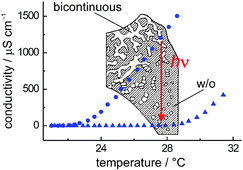Switching electrical conductivity in an AOT–isooctane–water microemulsion through photodimerization of solubilized N-methyl-2-quinolone
Abstract
The electrical conductivity of microemulsions composed of Aerosol OT (AOT),

* Corresponding authors
a
Technische Universität Dresden, Physikalische Chemie, Professur für Grenzflächen- und Kolloidchemie, D-01062 Dresden, Germany
E-mail:
thomas.wolff@chemie.tu-dresden.de
Fax: +49-351-463-33391
Tel: +49-351-463-33633
The electrical conductivity of microemulsions composed of Aerosol OT (AOT),

 Please wait while we load your content...
Something went wrong. Try again?
Please wait while we load your content...
Something went wrong. Try again?
M. Bufe and T. Wolff, Phys. Chem. Chem. Phys., 2006, 8, 4222 DOI: 10.1039/B606888J
To request permission to reproduce material from this article, please go to the Copyright Clearance Center request page.
If you are an author contributing to an RSC publication, you do not need to request permission provided correct acknowledgement is given.
If you are the author of this article, you do not need to request permission to reproduce figures and diagrams provided correct acknowledgement is given. If you want to reproduce the whole article in a third-party publication (excluding your thesis/dissertation for which permission is not required) please go to the Copyright Clearance Center request page.
Read more about how to correctly acknowledge RSC content.
 Fetching data from CrossRef.
Fetching data from CrossRef.
This may take some time to load.
Loading related content
